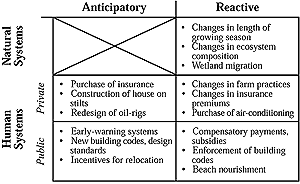|
18.2.4. Systems, Scales, and Actors
Adaptations occur in something (i.e., who or what adapts?), which is called
the "system of interest," "unit of analysis," "exposure
unit," "activity of interest," or "sensitive system"
(Carter et al., 1994; Smithers and Smit, 1997; UNEP, 1998; Reilly and Schimmelpfennig,
2000). In unmanaged natural systems, adaptation is autonomous and reactive
and is the means by which species and communities respond to changed conditions.
In these situations, adaptation assessment is essentially equivalent to natural
system impact assessment (addressed in other WGII chapters). This chapter focuses
on adaptations consciously undertaken by humans, including those in economic
sectors, settlements, communities, regions, and managed ecosystems.
Human system adaptation can be motivated by private or public interest (i.e.,
who adapts?). Private decisionmakers include individuals, households,
businesses, and corporations; public interests are served by governments
at all levels. The roles of public and private participants are distinct but
not unrelated. Figure 18-5 shows examples of types of adaptation differentiated
according to timing, natural or human systems, and public or private decisionmakers.
|

Figure 18-5: Types of adaptation to climate change,
including examples (from Klein, 1999).
|
Planned adaptation often is interpreted as the result of a deliberate policy
decision on the part of a public agency, based on an awareness that conditions
are about to change or have changed and that action is required to minimize
losses or benefit from opportunities (Pittock and Jones, 2000). Autonomous adaptations
are widely interpreted as initiatives by private actors rather than by governments,
usually triggered by market or welfare changes induced by actual or anticipated
climate change (Leary, 1999). Smith et al. (1996) describe autonomous adaptations
as those that occur "naturally," without interventions by public agencies,
whereas planned adaptations are called "intervention strategies."
Thus defined, autonomous and planned adaptation largely correspond with private
and public adaptation, respectively (see Figure 18-5).
The extent to which society can rely on autonomous, private, or market adaptation
to reduce the costs of climate change impacts to an acceptable or nondangerous
level is an issue of great interest. Autonomous adaptation forms a baseline
against which the need for planned anticipatory adaptation can be evaluated.
Distinguishing among the various decisionmakers involved in adaptation is important.
The case of African agriculture and water resources illustrates that stakeholders
and potential adapters range from vulnerable consumers to international organizations
charged with relief and research (Eele, 1996; Magadza, 1996; Downing et al.,
1997). Poor and landless households have limited resources, yet failure to adapt
can lead to significant deprivation, displacement, morbidity, and mortality.
Subsistence farmers do not have the same adaptation options as commercial producers.
Water supply adaptations may involve landowners, private traders, local authorities,
water-dependent businesses, national governments, and international organizations.
Each stakeholder has distinct interests, information, risks, and resources and
hence would consider distinct types of adaptive responses (Downing et al., 1997).
18.2.5. Processes and Evaluation of Adaptations
In order to predict autonomous adaptations and provide input to adaptation
policies, there is a need for improved knowledge about processes involved in
adaptation decisions. This knowledge includes information on steps in the process,
decision rationales, handling of uncertainties, choices of adaptation types
and timing, conditions that stimulate or dampen adaptation, and the consequences
or performance of adaptation strategies or measures (Burton, 1997; Rayner and
Malone, 1998; Tol et al., 1998; Basher, 1999; Klein et al., 1999; Pittock, 1999;
Smit et al., 1999).
Decisions regarding adaptations can be undertaken at any of several scales,
by private individuals, local communities or institutions, national governments,
and international organizations. Where these adaptations are consciously planned
activities, whether by public agencies or individuals, there is an interest
in assessing the performance or relative merits of alternative measures and
strategies (see Figure 18-4). This evaluation
(i.e., how good is the adaptation?) can be based on criteria such as costs,
benefits, equity, efficiency, and implementability (see Sections
18.3.5 and 18.4.3).
|